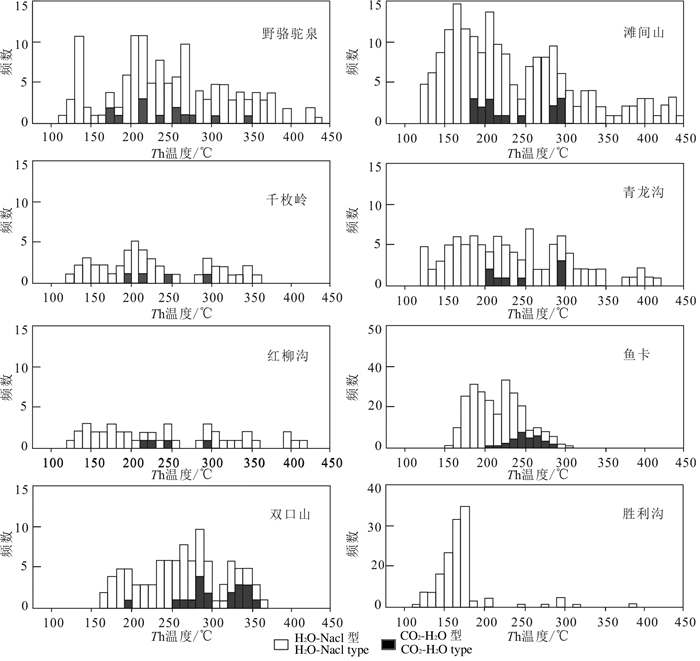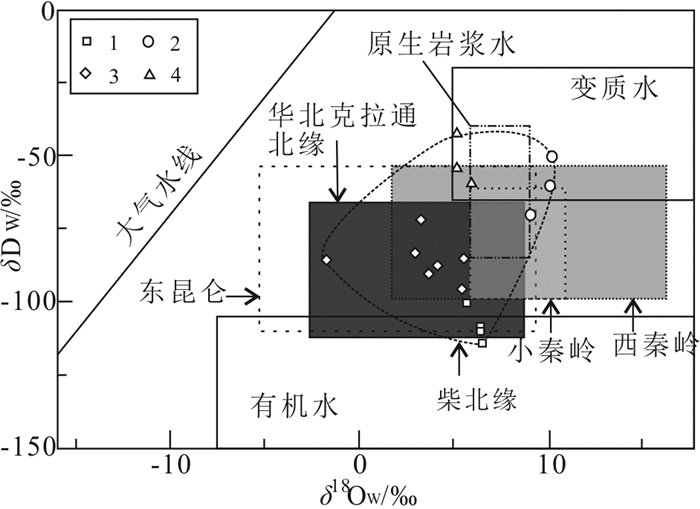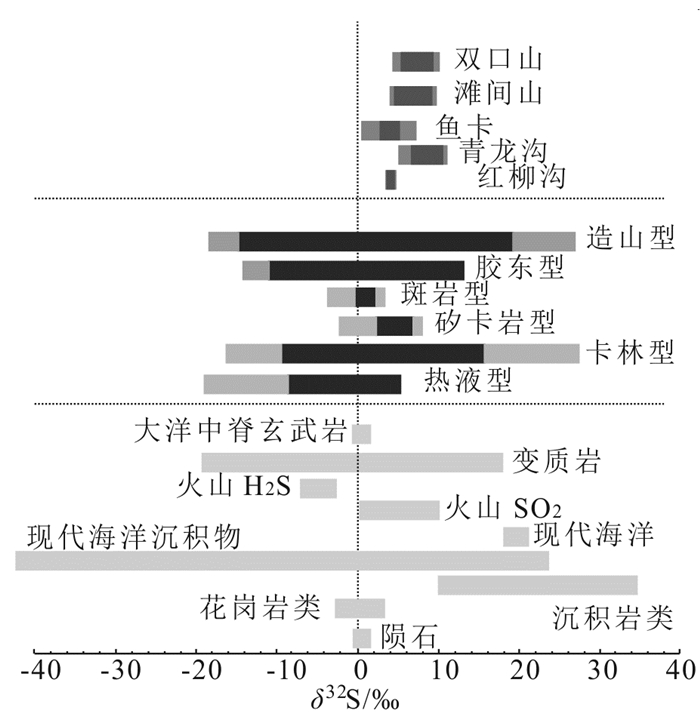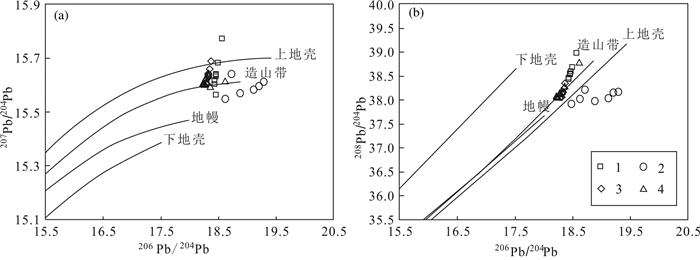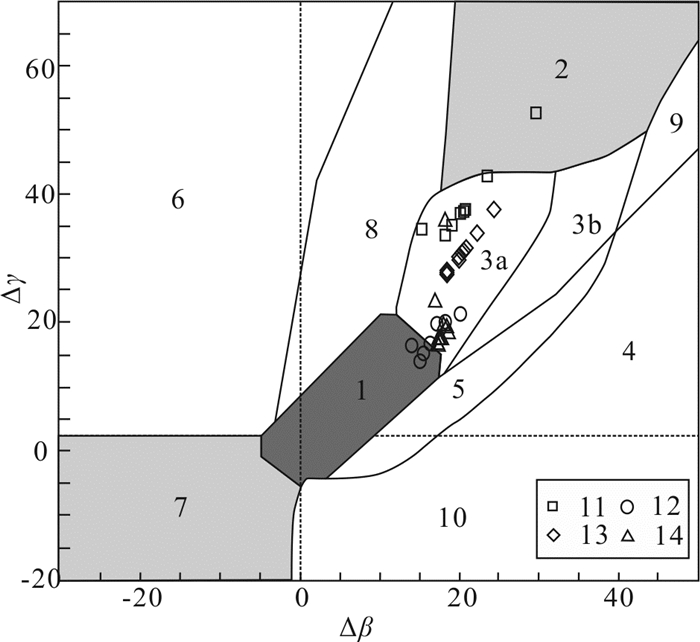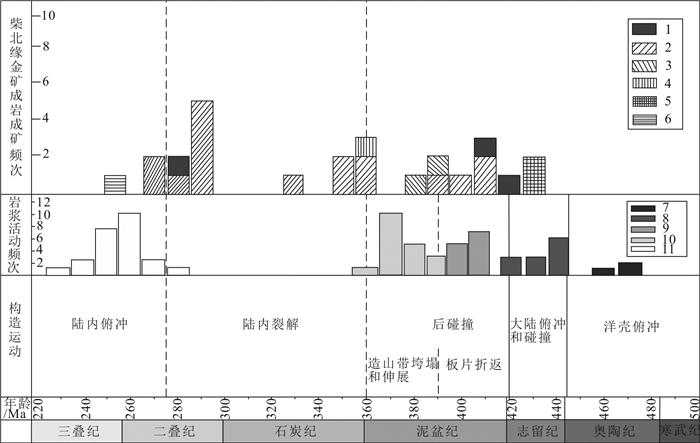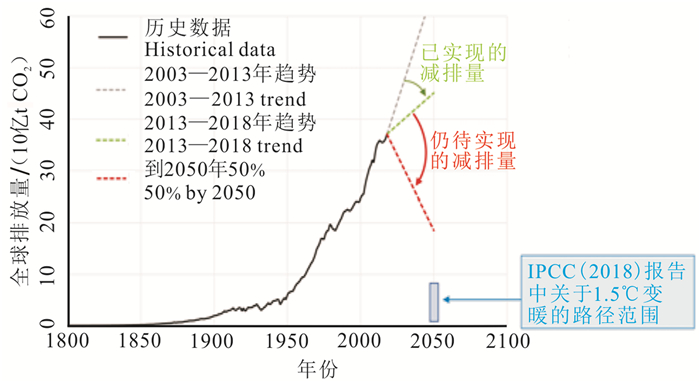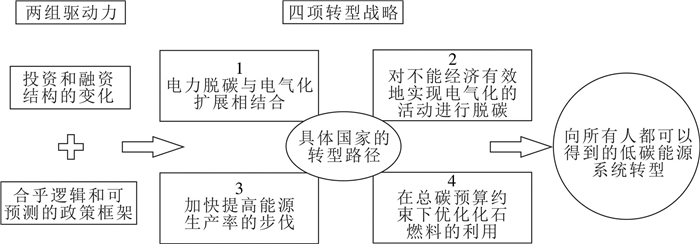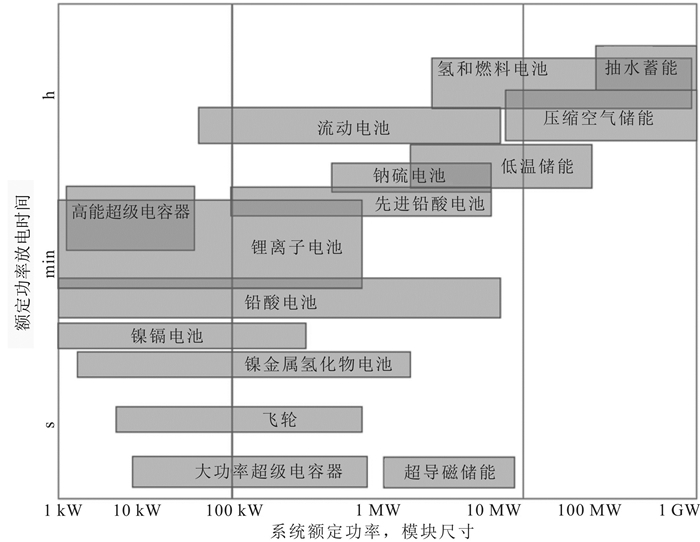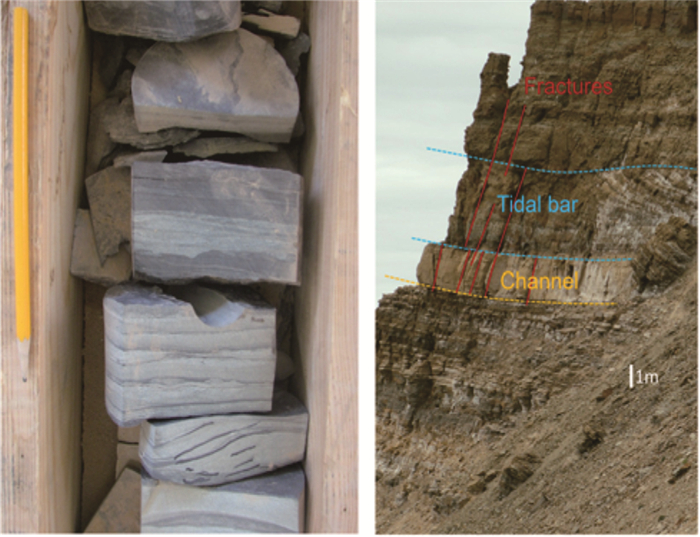-
摘要:
碳中和是当前世界关注的热点,地球科学可以在其中发挥很大的作用。在国际上,政府间气候变化专门委员会、国际能源署、能源转型委员会,以及在国家层面,政策咨询小组已就CO2减排可能的实现方式提出了一系列模型和预测情景,表明要实现碳中和,电将代替化石燃料成为全球能源的主要载体。在全球迫切需要减排的背景下,地球科学为实现《巴黎协定》气候目标提供地质解决方案至关重要,主要科学问题涉及:储热与地热;干热岩;水电储能;压缩空气储能;核能;碳捕集与储存;氢经济;能源转型需要的矿产原材料。这就需要地球科学:一是对岩石进行地球化学和地质体的岩石力学特征描述,以便在可能开展脱碳的地区储存CO2和建立绿色能源系统;二是进一步揭示电动汽车电池和风力涡轮机等所需矿产资源的起源和成因;三是从小型实验室尺度扩大到试点、工业化和商业化全尺度规模;四是要了解公众对地下脱碳技术的态度,保证项目安全性。碳中和目标为地球科学研究提供了新的机遇,未来发展需要从多方面提供支持;提高对地球科学在实现脱碳方面关键作用的认识,并发展技术,打造产业链,实现可持续发展。
Abstract:Carbon neutralization is a hot topic in the world, and geoscience can play an important role in this field. Internationally, the Intergovernmental Panel on Climate Change, the International Energy Agency, the Energy Transition Commission, and policy advisory groups at the national level have proposed a series of models and scenarios for possible ways to reduce CO2 emissions, indicating that to achieve carbon neutrality, electricity will replace fossil fuels as the main carrier of global energy. In the context of global urgent need for CO2 emission reduction, it is very important for geosciences to provide geological solutions to achieve the climate objectives of the Paris Agreement. Carbon dioxide emission reduction involves many scientific issues, including heat storage and geothermal, dry hot rock, hydropower energy storage, compressed air energy storage, nuclear energy, carbon capture and storage, hydrogen economy and mineral raw materials for energy transformation. Earth science can help reducing carbon dioxide emissions through the following ways: first, to describe the rock mechanics characteristics of geological body, so as to store CO2 and establish green energy system in the decarbonization area; secondly, to further reveal the origin and genesis of the mineral resources needed for electric vehicle batteries and wind turbines; thirdly, to expand the scale from small laboratory to pilot, industrialization and commercialization; and fourthly, to understand the public's attitude towards underground decarbonization technology to ensure the safety of the project. The goal of carbon neutralization provides new opportunities for geoscience research, and the future development needs support from various aspects. Achieving carbon neutrality requires improving awareness of the key role of geoscience in achieving decarbonization, developing technologies, building industrial chains, and achieving sustainable development.
-
1. 引言
造山型金矿床作为重要的金矿床类型,其占世界黄金资源的30%以上(Groves et al., 1988)。造山带中形成的造山型金矿床主要位于由挤压或走滑变形中应力相对低的区域,如次级断裂构造中(McCuaig et al., 1988)。大多数造山型金矿床是在绿片岩相变质条件下形成的(Goldfarb et al., 2001, 2015; Deng and Wang, 2016)。造山型金矿的成矿流体和金的来源是至今尚未解决的问题(卢焕章等, 2018)。一般认为成矿流体中的Au(HS)2-络合物是金元素运输及富集的载体(McCuaig et al., 1988)。金成矿流体来源多样,包括:(1)岩石变质作用(Groves et al., 2003); (2)含碳沉积物(Large et al., 2011); (3)岩浆热液(Tomkins et al., 2013); (4)海水(Chang et al., 2008); (5)变质脱水(Phillips and Powell, 2009, 2010)。事实上各个时代的大多数造山型金矿床的成矿流体具有盐度低(≤10%NaCleqv),高碳(CO2 + CH4含量为5%~30%),低Cl和高S含量等特征(卢焕章等, 2018)。而造山型金矿床成矿流体的一致性,说明它们可能来自相同或者是多阶段形成的热液流体(卢焕章, 1991;卢焕章和池国祥, 1995)。此外,造山型金矿的成矿时代也是其研究的热点,争论的焦点主要在于是形成于变质峰期前(Phillips and Powell, 2009, 2010;Tomkins, 2010)还是变质峰期与峰期后(Groves et al., 1998;Goldfarb et al., 2005)。前者主要认为造山带在抬升剥蚀过程中,变质峰期与地壳的深度有关,即越深则达到峰期的时间越晚,且也可能受到之后变质作用的叠加,从而表现出成矿时代比围岩变质时期晚(Phillips and Powell, 2010)。后者则基于造山型金矿的成矿时代统计(Knight et al., 1993, 2000;Dziggel et al., 2010;Kolb et al., 2015),并结合变质时代、蚀变特征、穿切关系等。同时,前人研究发现这些造山型金矿的成矿峰期与陆壳增生速率的峰期和超大陆拼合峰期吻合较好(Goldfarb et al., 2001)。
造山型金矿床也是中国重要的黄金来源,广泛分布于天山造山带(Chen et al., 2012),哀牢山构造带(Zhang et al., 2018),华北克拉通北缘(Hart et al., 2002)和中国西北的造山带(Mao et al., 2000; Zhang et al., 2009;李猛等,2020)。柴达木盆地北缘(简称柴北缘)造山带是中国西北部的重要的造山带之一,含有一系列Au、Cu、Pb和Zn矿床(Zhang et al., 2009)。本区是中国重要的金成矿带,目前发现9个金矿床,金矿化点十余处,远景资源量在300 t以上。前人研究认为这些金矿与造山作用密切相关,但缺乏系统性总结,从而限制了我们对柴北缘造山型金矿的理解。本文在前人研究和最新地质资料的基础上,对柴北缘造山型金矿进行初步探讨,希望能够对柴北缘造山型金矿的找矿工作有所启迪。
2. 地质背景
柴北缘造山带整体走向为西北-东南,长约900 km,宽25~160 km(图 1)。北邻祁连造山带,南接柴达木地块(柴达木盆地)(Song et al., 2014; 蔡鹏捷等,2019)。欧龙布鲁克—牦牛山断裂将柴北缘从欧龙布鲁克地块向北分离(Chen et al., 2009)。在其西北端,造山带被阿尔金断裂切割(Wittlinger et al., 1998)。前人研究表明,柴达木盆地北部在早奥陶世发生俯冲,与祁连地块的碰撞发生在晚奥陶世到中泥盆世(Yang, 2002; 蔡鹏捷等, 2018)。
![]() 1—胜利沟金矿;2—野骆驼泉金矿;3—千枚岭金矿;4—红柳沟金矿;5—青龙沟金矿;6—滩间山金矿;7—鱼卡金矿;8—双口山金矿;9—赛坝沟金矿Figure 1. Schematic map showing the major tectonic units in northwest China (a, modified from Song et al., 2013) and simplified map showing the tectonic framework of the northern Qaidam(b, modified from Zhang et al., 2009)1-Shengligou gold deposit; 2-Yeluotuoquan gold deposit; 3-Qianmeiling gold deposit; 4-Hongliugou gold deposit; 5-Qinglonggou gold deposit; 6-Tanjianshan gold deposit; 7-Yuka gold deposit; 8-Shuangkoushan gold deposit; 9-Saibagou gold deposit
1—胜利沟金矿;2—野骆驼泉金矿;3—千枚岭金矿;4—红柳沟金矿;5—青龙沟金矿;6—滩间山金矿;7—鱼卡金矿;8—双口山金矿;9—赛坝沟金矿Figure 1. Schematic map showing the major tectonic units in northwest China (a, modified from Song et al., 2013) and simplified map showing the tectonic framework of the northern Qaidam(b, modified from Zhang et al., 2009)1-Shengligou gold deposit; 2-Yeluotuoquan gold deposit; 3-Qianmeiling gold deposit; 4-Hongliugou gold deposit; 5-Qinglonggou gold deposit; 6-Tanjianshan gold deposit; 7-Yuka gold deposit; 8-Shuangkoushan gold deposit; 9-Saibagou gold deposit柴北缘的主要岩石地层单位包括古元古界达肯大板岩群、中—新元古界鱼卡河岩群、滩间山岩群和下古生界弧相关的火山和沉积岩(Zhang et al., 2017a, b)。柴北缘作为著名的超高压变质带,前人通过对高压/超高压变质岩(榴辉岩和片麻岩)和花岗岩的地质年代学和地球化学研究,建立了一个大陆碰撞造山带从早期海底俯冲(>440 Ma)、大陆俯冲和碰撞(440~ 420 Ma)、俯冲板块的剥露(420~390 Ma)和最终造山带崩塌(390~360 Ma)的演化模型(Song et al., 2014;张建新等, 2015;Zhang et al., 2017a, b)。
3. 柴北缘造山型金矿床地质概况
俯冲相关增生造山作用的成矿模型预测,柴北缘有利于造山型成矿(Goldfarb et al., 2001, 2015; Deng and Wang, 2016)。柴北缘造山带已发现大量的造山型金矿床,包括胜利沟、野骆驼泉、千枚岭、红柳沟、青龙沟、滩间山、赛坝沟、鱼卡和双口山,以蚀变岩型和石英脉型为主(国家辉, 1998;张德军, 2001, 2005, 2007a, 2007b;Zhang et al., 2009;范贤斌, 2017;孟和, 2017;蔡鹏捷等, 2018)。
柴北缘造山型金矿的地质特征见表 1。总体上,柴北缘的造山带金矿体主要赋存于中元古界、寒武系和奥陶系低品位变质岩发育的剪切带中(Deng and Wang, 2016)。其中胜利沟、野骆驼泉、千枚岭、红柳沟、鱼卡和双口山金矿主要产于寒武—奥陶系滩间山群,青龙沟和滩间山金矿产于中元古界万洞沟群,赛坝沟金矿的赋矿围岩为中粗粒花岗闪长岩-英云闪长岩。基本上所有金矿的围岩蚀变包括硅化、绿泥石化、绢云母化,部分还有碳酸盐化(千枚岭、红柳沟、滩间山、鱼卡、双口山),黄铁绢英岩化(赛坝沟金矿)。多数金矿体的展布与NW向的韧性剪切或断层破碎带相关,少数还与次级构造有关(野骆驼泉、千枚岭、青龙沟、滩间山、双口山)。矿石构造大部分为浸染状、细脉浸染状,部分可见团块状矿石(滩间山和鱼卡)。这些金矿的元素组合均表现为Au-As。
Table 1. Geological characteristics of the orogenic gold deposits in Northern Qaidam
4. 金矿成矿温度特征
对柴北缘造山型金矿与成矿相关的流体包裹体均一温度、冰点、盐度等进行统计(表 2,图 2):野骆驼泉(CO2-H2O型:峰值177~261℃和270~341℃,盐度为1.6%~8.9%;H2O-NaCl型:119~437℃,冰点为-7.8~-0.9℃,盐度为1.6%~11.4%)(张德全等, 2001)、滩间山(CO2-H2O型:峰值在186~250℃和280~296℃,盐度为1.4%~7.9%;H2O-NaCl型:121~ 449℃,冰点为-7.0~-0.9℃,盐度为1.6%~10.5%) (张德全等, 2001)、千枚岭(CO2-H2O型:峰值191~ 243℃,299℃,盐度为2.4%~7.3%;H2O-NaCl型:124~358℃,冰点-6.9~-1.5℃,盐度为2.6%~10.3%) (张德全等, 2001)、青龙沟(CO2- H2O型:200~ 245℃,293~299℃,盐度为1.8%~8.3%;H2O-NaCl型:129~418℃,冰点为-6.0~-0.7℃,盐度为1.2%~ 9.2%)(张德全等, 2001)、红柳沟(CO2-H2O型:213~ 245℃,295℃,盐度为2.4%~8.1%;H2O-NaCl型:129~420℃,冰点为- 5.9~- 1.2℃,盐度为2.1% ~ 9.1%)(张德全等, 2001)、鱼卡(CO2-H2O型:193~ 249℃;H2O- NaCl型:188~285℃,冰点为- 7.5~-0.7℃,盐度为1.22%~11.10%)(范贤斌, 2017;蔡鹏捷, 2018)、双口山(CO2-H2O型:252~290℃,320~ 358℃;H2O-NaCl型:161~365.6℃,冰点为-5.6~ -3.0℃,盐度为1.91%~14.25%)(孟和, 2017)、胜利沟(H2O- NaCl型:120~209℃,206~385℃,冰点为-9.7~-1.8℃,盐度为3.06%~13.62%)(黄亚, 2013)。
Table 2. Temperature measurement data of fluid inclusions of orogenic gold deposits in the northern Qaidam (datas from Zhang et al., 2001; Huang, 2013; Fan, 2017; Meng, 2017; Cai et al., 2018)
![]() Figure 2. Histogram showing homogenization temperature of fluid inclusions of the orogenic gold deposits in the northern Qaidam (after Zhang et al., 2001; Huang, 2013; Fan, 2017; Meng, 2017; Cai et al., 2018c)
Figure 2. Histogram showing homogenization temperature of fluid inclusions of the orogenic gold deposits in the northern Qaidam (after Zhang et al., 2001; Huang, 2013; Fan, 2017; Meng, 2017; Cai et al., 2018c)不难看出,成矿流体的均一在各个矿床之间存在一定的差异。这种差异应该是与成矿作用时的压力-温度不同有关,也与围岩的组成有关。但这些矿床的成矿温度还是在200~400℃,仅有几十度的差别,均在造山型金矿的成矿温度(卢焕章等, 2018)。大部分矿床(点) 中呈双峰态分布, 只有少部分矿床(点)中呈单峰态分布。张德全(2007)对柴北缘—东昆仑金矿流体包裹体研究认为,这可能与不同造山时期的成矿作用有关,且对应了低盐度的H2O-CO2-NaCl-CH4(晚加里东碰撞造山期)和H2O-CO2-NaCl±CH4(晚华力西—印支碰撞造山期)两种不同的成矿流体。
一般认为金成矿具有多个成矿阶段, 从早期的高温阶段到后期的低温阶段(卢焕章等, 2018)。金矿化主要包含了4个阶段:①乳白色石英黄铁矿阶段;②含金石英黄铁矿阶段;③含金多金属硫化物石英阶段;④碳酸盐阶段(卢焕章等, 2018)。前人对柴北缘造山型金矿流体包裹体的研究主要针对与金矿的成矿流体相关第二和第三阶段。对柴北缘造山型金矿的流体包裹体显微观察,均发现有富CO2型、含CO2水溶液型(CO2-H2O型)和水溶液型(H2O-NaCl型) 三类,这与典型的造山型金矿中流体包裹体类型是一致的(Groves et al., 1998; Kerrich et al., 2000; Hagemann and Cassidy, 2000; 陈衍景等, 2007)。
5. 金成矿流体与物质来源
5.1 氢、氧同位素特征
利用与成矿相关的氢、氧同位素,能够有效地揭示成矿流体的来源,区分其来源岩浆水、变质水或大气降水,从而有助于判别流体的演化轨迹和矿床成因(杨利亚等, 2013)。造山型金矿的成矿流体往往经历了长距离迁移,其氢、氧同位素组成除了反映源区性质之外,可能表征沿着流体通道的水/岩反应、源区和围岩或后期流体的混合特征(Ridley and Diamond, 2000; Beaudoin and Pitre, 2005; 蔡鹏捷, 2019)。
柴北缘造山型金矿成矿流体中δ18OH2O-SNOW = -1.7‰ ~ 10.31‰和δDV- SMOW = -113.8 ‰~ -41.6 ‰ (表 3,图 3),其中滩间山金矿δ18OH2O-SNOW = 9.15‰ ~ 10.31‰,δDV-SMOW=-69.9‰ ~ -50‰;青龙沟金矿δ18OH2O - SNOW =- 1.7‰ ~ 5.5‰,δDV- SMOW=- 95.1‰ ~ -71.4‰;鱼卡金矿δ18OH2O-SNOW =5.2‰ ~ 6.01‰,δDV-SMOW=-58.5‰ ~-41.6‰;双口山金矿δ18OH2O-SNOW = 5.75‰ ~ 6.45‰,δDV-SMOW=-113.8‰ ~ -99.8‰。柴北缘这些金矿的H-O同位素特征,是无法用单一大气水或原生岩浆水的参与解释,只有是在复杂的造山过程中变质流体受到岩浆水及大气水等共同作用所导致。从图 3也可见,整个柴北缘金矿的H-O同位素基本上也与华北克拉通北缘、小秦岭、西秦岭、东昆仑等造山带中的造山型金矿范围重叠。
表 3 柴北缘造山型金矿H-O同位素Table 3. δ18O and δD values of the orogenic gold deposits in the northern Qaidam
![]() 图 3 柴北缘造山型金矿δD与δ18Owater比值图(底图据Deng and Wang, 2016)1—双口山金矿;2—滩间山金矿;3—青龙沟金矿;4—鱼卡金矿Figure 3. δD (‰) vs. δ18Owater (‰) diagram of the orogenic gold deposits in the northern Qaidam (modified from Deng and Wang, 2016)1-Shuangkoushan gold deposit; 2-Tanjianshan gold deposit; 3- Qinglonggou gold deposit; 4-Yuka gold deposit
图 3 柴北缘造山型金矿δD与δ18Owater比值图(底图据Deng and Wang, 2016)1—双口山金矿;2—滩间山金矿;3—青龙沟金矿;4—鱼卡金矿Figure 3. δD (‰) vs. δ18Owater (‰) diagram of the orogenic gold deposits in the northern Qaidam (modified from Deng and Wang, 2016)1-Shuangkoushan gold deposit; 2-Tanjianshan gold deposit; 3- Qinglonggou gold deposit; 4-Yuka gold deposit5.2 硫、铅同位素特征
硫化物的硫同位素组成对于追踪成矿物质来源和约束成矿过程是非常有效的(Hodkiewicz et al., 2009)。柴北缘金矿中含金黄铁矿的δ34S在0.5‰~ 11‰,主要集中在5‰~9‰(表 4,图 4),其中滩间山金矿δ34S为5.31‰~8.54‰;青龙沟金矿δ34S为5.0‰ ~11.0‰;鱼卡金矿δ34S为0.5‰~7.4‰;双口山金矿δ34S为6.0‰ ~10.0‰;红柳沟金矿δ34S为3.9‰ ~4.4‰。总体柴北缘金矿黄铁矿的δ34S与金矿类型进行对比,主要落在造山型金矿和卡林型金矿范围内,源区特征主要落在变质岩类型的范围内(图 4),推测成矿流体在上升过程中与通道围岩发生水-岩作用而产生的混合硫,总体上指示了带内的金矿应属于造山型金矿。
表 4 柴北缘造山型金矿S同位素特征Table 4. Analytical results of S isotope of the orogenic gold deposits in Northern Qaidam
![]() 图 4 柴北缘造山型金矿与其他类型S同位素对比(据Deng and Wang, 2016修改)Figure 4. Comparison of S isotopes between orogenic gold deposits in the northern margin of Qaidam and other types of gold deposits
图 4 柴北缘造山型金矿与其他类型S同位素对比(据Deng and Wang, 2016修改)Figure 4. Comparison of S isotopes between orogenic gold deposits in the northern margin of Qaidam and other types of gold deposits矿石的铅同位素同样是一类对成矿来源的有效示踪工具(Doe and Stacey, 1974; Zartman and Doe, 1981)。柴北缘金矿中黄铁矿或共生方铅矿的206Pb/204Pb为18.238~19.296,207Pb/204Pb为15.547~ 15.773,208Pb/204Pb为37.918~38.978,∆β为14.15~ 29.79,∆γ为11.95~51.92(表 5)。其中胜利沟金矿中方铅矿的206Pb/204Pb为18.300~18.374,207Pb/204Pb为15.602~15.688,208Pb/204Pb为38.054~38.346,∆β为14.15~20.28,∆γ为11.95~18.38(表 5);滩间山金矿中黄铁矿的206Pb/204Pb为18.476~19.296,207Pb/204Pb为15.547~15.641,208Pb/204Pb为37.918~38.211,∆β为18.55~24.41,∆γ为28.66~36.42(表 5);鱼卡金矿中黄铁矿的206Pb/204Pb为18.238~18.62,207Pb/204Pb为15.59~ 15.618,208Pb/204Pb为38.039~38.775,∆β为16.96~ 18.78,∆γ为15.29~34.82(表 5);双口山金矿中方铅矿的206Pb/204Pb为18.437~18.567,207Pb/204Pb为15.617~ 15.773,208Pb/204Pb为38.466~38.978,∆β为15.33~ 29.79,∆γ为32.26~51.92,黄铁矿的206Pb/204Pb为18.435~18.460,207Pb/204Pb为15.604~15.634,208Pb/204Pb为38.431~38.531,∆β为18.24~20.91,∆γ为26.03~ 30.10(表 5)。柴北缘金矿含金矿物的Pb同位素投点可见主要落在了上地壳和造山带演化线之间(图 5),这些Pb同位素特征说明柴北缘金矿的成矿物质大多来源于地幔—上地壳的混合作用(图 6),且一定程度上受到了岩浆作用的影响,也指示了其应该与造山作用相关。
表 5 柴北缘造山型金矿Pb同位素特征Table 5. Pb-isotpic compositions and characteristic parameters of orgen gold deposits in the northern Qaidam
![]() 图 5 柴北缘造山型金矿Pb同位素构造图解(底图据Zartman and Doe, 1981)1—双口山金矿;2—滩间山金矿;3—胜利沟金矿;4—鱼卡金矿Figure 5. Pb isotope diagrams of the orogenic gold deposits in the northern Qaidam (basic diagram modified from Zartman and Doe, 1981)Pb isotope diagrams of the orogenic gold deposits in the northern Qaidam (basic diagram modified from Zartman and Doe, 1981)
图 5 柴北缘造山型金矿Pb同位素构造图解(底图据Zartman and Doe, 1981)1—双口山金矿;2—滩间山金矿;3—胜利沟金矿;4—鱼卡金矿Figure 5. Pb isotope diagrams of the orogenic gold deposits in the northern Qaidam (basic diagram modified from Zartman and Doe, 1981)Pb isotope diagrams of the orogenic gold deposits in the northern Qaidam (basic diagram modified from Zartman and Doe, 1981)![]() 图 6 柴北缘造山型金矿Pb同位素Δβ-Δγ图解(底图据朱炳泉等, 1998)1—地幔源Pb; 2—上地壳源Pb; 3—上地壳与地幔混合的俯冲带Pb (3a—岩浆作用; 3b—沉积作用); 4—化学沉积型Pb; 5—海底热水作用Pb; 6—中深变质作用Pb; 7—深变质下地壳Pb; 8—造山带Pb; 9—古老页岩上地壳Pb; 10—退变质作用Pb;11—双口山金矿;12—滩间山金矿;13—胜利沟金矿;14—鱼卡金矿Figure 6. Pb isotope Δβ-Δγ diagram of the orogenic gold deposits in the northern Qaidam (basic diagram modified from Zhu et al., 1998)1- mantle lead; 2-upper crust lead; 3- subduction zone lead mixed with upper crust and mantle(3a -magmatism; 3b- deposition); 4- chemical deposition lead; 5- submarine hot water lead; 6-mesometamorphism lead; 7- katametamorphism lower crust lead; 8-orogenic belt lead; 9- ancient shale upper crust lead; 10- retrograde metamorphism lead; 11-Shuangkoushan gold deposit; 12-Tanjianshan gold deposit; 13-Shengligou gold deposit; 14-Yuka gold deposit
图 6 柴北缘造山型金矿Pb同位素Δβ-Δγ图解(底图据朱炳泉等, 1998)1—地幔源Pb; 2—上地壳源Pb; 3—上地壳与地幔混合的俯冲带Pb (3a—岩浆作用; 3b—沉积作用); 4—化学沉积型Pb; 5—海底热水作用Pb; 6—中深变质作用Pb; 7—深变质下地壳Pb; 8—造山带Pb; 9—古老页岩上地壳Pb; 10—退变质作用Pb;11—双口山金矿;12—滩间山金矿;13—胜利沟金矿;14—鱼卡金矿Figure 6. Pb isotope Δβ-Δγ diagram of the orogenic gold deposits in the northern Qaidam (basic diagram modified from Zhu et al., 1998)1- mantle lead; 2-upper crust lead; 3- subduction zone lead mixed with upper crust and mantle(3a -magmatism; 3b- deposition); 4- chemical deposition lead; 5- submarine hot water lead; 6-mesometamorphism lead; 7- katametamorphism lower crust lead; 8-orogenic belt lead; 9- ancient shale upper crust lead; 10- retrograde metamorphism lead; 11-Shuangkoushan gold deposit; 12-Tanjianshan gold deposit; 13-Shengligou gold deposit; 14-Yuka gold deposit6. 柴北缘造山型金成矿时代
前人对柴北缘构造带中的金矿相关的成岩成矿时代进行了厘定(表 6):野骆驼泉金矿成矿时代为(246.0±3.0)Ma(张德全等, 2005);青龙沟金矿成矿时代为(409.4±2.3)Ma(张德全等, 2005)、(410.3± 5.8)Ma(张德全等, 2005)、274.6 Ma(林文山等, 2006);滩间山金矿成矿时代为409.4 Ma(张德全等., 2001)、401 Ma(张德全等, 2001)、(394±6)Ma (Li, 2011)、385.8 Ma(崔艳合等, 2000)、(356±2.8) Ma(贾群子等, 2013)、(350.4 ± 3.2)Ma(张博文, 2010)、(344.7±2)Ma(李世金, 2011)、(344±2.2)Ma(张博文, 2010)、(330±24.3)Ma(张德全等, 2001)、(288.9±7.3)Ma(崔艳合等, 2000)、(289.6±6)Ma(崔艳合等, 2000)、288 Ma(Zhang et al., 2009)、(284.04±2.95)Ma(张德全等, 2005)、284 Ma(张德全等, 2005)、(275.9 ± 7.2)Ma(崔艳合等, 2000)、(268.94 ± 4.31)Ma(崔艳合等, 2000)、268.9 Ma (Zhang et al., 2009)、209 Ma(国家辉, 1998);鱼卡金矿成矿时代为(376.9±4.0)Ma、(387.5±7.2)Ma(范贤斌, 2017);双口山金矿成矿时代为(357.7±5.28)Ma (孟和, 2017);赛坝沟金矿成矿时代为(425.5±2.1) Ma(丰成友等, 2002)、(426±2)Ma(张德全等, 2005)、(210±3)Ma(丰成友等, 2002)。上述成矿时代指示了柴北缘造带中的金矿大多与复合造山过程有关。
表 6 柴北缘造山型金矿相关成岩与成矿时间Table 6. Diagenetic and metallogenic ages of orogenic gold deposits in the northern Qaidam
将柴北缘金矿成矿时期与岩浆活动和构造运动分期进行对比(图 7),综合前人研究,可见寒武—奥陶纪时期,柴北缘的洋盆逐渐关闭,洋壳俯冲导致岛弧火山岩(滩间山岩群)的形成,洋壳俯冲结束后,柴达木地块与欧龙布鲁克微陆块开始碰撞,形成了加里东期的柴北缘碰撞造山带(赵志新,2018),造山期后的一系列岩浆活动奠定了柴北缘造山型金矿形成的基础(张德全等, 2001, 2005;Zhang et al., 2009)。整个柴北缘造山型金矿的成矿期主要集中在426~376 Ma、357~330 Ma和288~246 Ma三个时期。第一个成矿期与区域的加里东期碰撞造山过程相关,第二成矿期与陆内裂解的岩浆活动有关,第三成矿期则与晚华力西—印支期造山过程有关。其中加里东晚期,柴达木陆块向祁连陆块的俯冲由正向俯冲变成斜向俯冲,导致区域上形成了一条右行剪切走滑构造带,同时柴北缘这种应力的转变也进一步促进了岩浆活动的加剧及地层的褶皱变形,从而导致成矿热液流体沿原有构造体系发生叠加富集(丰成友等, 2002; 张德全等, 2005)。从时间上,不难看出,第一时期是属于柴北缘超高压变质峰期之后,该期矿床成矿时代的差异应该是所处不同位置及成矿深度导致。第二成矿期属于柴北缘碰撞造山后地壳增厚后减薄时期,岩浆活动对金矿的进一步富化。第三成矿期则是古特提斯洋的开合导致该区新的造山活动,热液与岩浆新的叠加作用。事实上,一般认为挤压或者从伸展到挤压的转换阶段,才是造山型金矿最有利的形成时期(王庆飞等,2019)。柴北缘大部分的造山型金矿都属于一次造山作用的产物,而带内滩间山、青龙沟、塞巴沟等经历了两期以上,其中滩间山金矿的三期复合成矿作用可能是导致其成为柴北缘最大金矿的原因。
![]() 图 7 柴北缘构造事件、岩浆活动与金矿成矿时代耦合图(据赵志新,2018修改)1—青龙沟金矿;2—滩间山金矿;3—鱼卡金矿;4—双口山金矿;5—赛坝沟金矿;6—野骆驼泉金矿;7—镁质钙性-钙碱性花岗岩;8—钙碱性花岗岩;9—钙碱-碱钙性花岗岩;10—钙碱花岗岩、拉斑质基性岩;11—碱性花岗岩Figure 7. Coupling diagram showing tectonic event, magmatic activity and metallogenic age of gold deposits in the northern Qaidam (modified from Zhao Zhixin, 2018)1-Qinglonggou gold deposit; 2-Tanjianshan gold deposit; 3-Yuka gold deposit; 4-Shuangkoushan gold deposit; 5-Saibagou gold deposit; 6- Yeluotuoquan gold deposit; 7-Magnesian calc alkaline granite; 8-Calc alkaline granite; 9-Calc alkaline- alkali calcium granite; 10-Calc alkaline granite, tholeiitic basic rock; 11-Alkaline granite
图 7 柴北缘构造事件、岩浆活动与金矿成矿时代耦合图(据赵志新,2018修改)1—青龙沟金矿;2—滩间山金矿;3—鱼卡金矿;4—双口山金矿;5—赛坝沟金矿;6—野骆驼泉金矿;7—镁质钙性-钙碱性花岗岩;8—钙碱性花岗岩;9—钙碱-碱钙性花岗岩;10—钙碱花岗岩、拉斑质基性岩;11—碱性花岗岩Figure 7. Coupling diagram showing tectonic event, magmatic activity and metallogenic age of gold deposits in the northern Qaidam (modified from Zhao Zhixin, 2018)1-Qinglonggou gold deposit; 2-Tanjianshan gold deposit; 3-Yuka gold deposit; 4-Shuangkoushan gold deposit; 5-Saibagou gold deposit; 6- Yeluotuoquan gold deposit; 7-Magnesian calc alkaline granite; 8-Calc alkaline granite; 9-Calc alkaline- alkali calcium granite; 10-Calc alkaline granite, tholeiitic basic rock; 11-Alkaline granite7. 结论
(1) 柴北缘造山型金矿主要赋存在中元古代、寒武系和奥陶系低品位变质岩发育的剪切带中,且多数矿体的展布与NW向的构造相关。
(2) 柴北缘造山型金矿大部分矿床(点) 成矿温度呈双峰态分布, 只有少部分矿床(点)中呈单峰态分布,指示了受到多期流体作用。
(3) 柴北缘造山型金矿的成矿流体中δ18OH2O-SMOW=-1.7‰ ~ 10.31‰和δDV-SMOW = -113.8 ‰ ~ -41.6 ‰,指示其变质流体受到岩浆水及大气水等共同作用。含金硫化物(黄铁和方铅矿)的δ34S在0.5‰ ~11‰,主要集中在5‰ ~9‰,206Pb/204Pb为18.238~19.296,207Pb/204Pb为15.547~15.773,208Pb/204Pb为37.918~38.978,指示了成矿物质来源于地幔-上地壳,且一定程度上都受到了岩浆作用的影响。
(4)柴北缘的复合造山运动导致造山型金矿存在(426~376)Ma、(357~330)Ma和(288~246)Ma三个成矿期。
-
图 3 能源转型委员会(2017年)4个转型战略(据Lindsay Delevingne et al., 2020)
Figure 3. Four transition strategies of the Energy Transitions Commission (2017)(after Lindsay Delevingne et al., 2020)
图 5 储存场地的地质特征(据Phil Ringrose,2019)
(左图阿尔及利亚克雷奇巴石炭纪储集单元潮汐三角洲岩相典型岩心样品;右图格陵兰中侏罗纪尼尔—克林特组潮汐三角洲沉积结构的露头代表)
Figure 5. Geological characteristics of storage-site(after Phil Ringrose, 2019)
(left) example core samples from a tidal delta lithofacies from the Carboniferous storage unit at Krechba, Algeria; and (right) outcrop analogue of tidal deltaic sedimentary architecture from the Middle Jurassic Neill Klinter Formation, Greenland. (Photographs courtesy of Phil Ringrose)
表 1 联合国可持续发展目标到2030年的目标和指标
Table 1 The 2030 goals and targets of the United Nations Sustainable Development Goals (SDGs)

-
Benjamin K, Sovacool, Saleem H, Ali Morgan Bazilian, Ben Radley, Benoit Nemery, Julia Okatz, Dustin Mulvaney. 2020. Sustainable minerals and metals for a low-carbon future[J]. Science, 367(6473): 30-33. doi: 10.1126/science.aaz6003
Brad Page, Guloren Turan, Alex Zapantis. 2019. Global Status of CCS 2019[R]. Melbourne: Global Carbon Capture and Storage Institute Ltd.
Carbon Brief. 2015. Nuclear power additions 'need to quadruple' to hit climate goals, IEA says[EB/OL]. [2015-01-31]. https://www.carbonbrief.org/nuclear-power-additions-need-to-quadruple-to-hit-climate-goals-iea-says.
China Petrochemical News. 2019. Definition and resources of dry hot rock[EB/OL]. [2019-12-23]. http://202.149.227.159/zgshb/html/2019-12/23/content_841175.htm?div=-1.
CHUNENG. BJX. COM. CN. 2016. How many of the world's top ten pumped storage power stations do you know?[EB/OL]. [2016-01-22]. http://chuneng.bjx.com.cn/news/20160122/703734.shtml.
Committee on Climate Change. 2019. Net Zero: The UK's Contribution to Stopping Global Warming[R]. London: Committee on Climate Change.
Energy Transitions Commission. 2017. Better Energy, Greater Prosperity Achievable Pathways to Low-carbon Energy Systems[R]. Energy Transitions Commission.
ESA. 2021 Variable Speed Pumped Hydroelectric Storage[EB/OL]. [2021-02-01]. http://energystorage.org/why-energy-storage/technologies/variable-speed-pumped-hydroelectric-storage/.
Gibbins J, Chalmers H. 2008. Carbon capture and storage[J]. Energy Policy, 36: 4317-4322. doi: 10.1016/j.enpol.2008.09.058
Goldthau A, Westphal K, Bazilian M, Bradshaw M. 2019. Model and manage the changing geopolitics of energy[J]. Nature, 569: 29-31. doi: 10.1038/d41586-019-01312-5
Helen Mountford. 2020. Responding to Coronavirus: Low-carbon Investments Can Help Economies Recover. [EB/OL]. [2020-03-12]. https://www.wri.org/blog/2020/03/coronavirus-economy-low-carbon-investments.
He Wei, Dooner Mark, King Marcus, Li Dacheng, Guo Songshan, Wang Jihong. 2021. Techno-economic analysis of bulk-scale compressed air energy storage in power system decarbonisation[J]. Applied Energy, 282(PA): 1-15. http://www.sciencedirect.com/science/article/pii/S0306261920315208
IEA. 2020. CCUS in Clean Energy Transitions[EB/OL]. [2020-09-01]. https://www.iea.org/reports/ccus-in-clean-energy-transitions/a-new-era-for-ccus#abstract.
IEA. 2018. World Energy Outlook 2018[R]. Paris: International Energy Agency.
IPCC. 2018. Summary for policymakers//Masson-Delmotte V, Zhai P. (eds.). Global Warming of 1.5℃. An IPCC Special Report on the Impacts of Global Warming of 1.5℃ Above Pre-industrial Levels and Related Global Greenhouse Gas Emission Pathways, in the Context of Strengthening the Global Response to the Threat of Climate Change, Sustainable Development, and Efforts to Eradicate Poverty[R]. Geneva: World Meteorological Organization.
IRENA. 2019. Global Energy Transformation: A Roadmap to 2050[R]. Abu Dhabi: International Renewable Energy Agency.
Johannes Friedrich, Thomas Damassa, Mengpin Ge. 2015. What Will Future Emissions Look Like?[EB/OL]. [2015-03-09]. https://www.wri.org/blog/2015/03/what-will-future-emissions-look.
Jose M Bermudez, Taku Hasegawa. 2020. Hydrogen: More efforts needed[EB/OL]. [2020-06]. https://www.iea.org/reports/hydrogen.
Kirsten Hund, Daniele La Porta, Thao P. Fabregas. 2020. Minerals for Climate Action: The Mineral Intensity of the Clean Energy Transition[R]. Washington, DC: The World Bank.
Lindsay Delevingne, Will Glazener, Liesbet Grégoir. 2020. Climate risk and decarbonization: What every mining CEO needs to know[R]. New York City: Mckinsey&Company.
Mao Xiang, Guo Dianbin, Luo Lu, Wang Tinghao. 2019. The global development process of hot dry rock (enhanced geothermal system) and its geological background[J]. Geological Review, 65(6): 1462-1472(in Chinese with English abstract). http://en.cnki.com.cn/Article_en/CJFDTotal-DZLP201906018.htm
Mark P Mills. 2020. Mines, Minerals, And "Green" Energy: A Reality Check[R]. New York: Manhattan Institute.
Michael H. Stephenson, Philip Ringrose, Sebastian Geiger, Michael Bridden, David Schofield. 2019. Geoscience and decarbonization: current status and future directions[J]. Petroleum Geoscience, 25: 501-508. doi: 10.1144/petgeo2019-084
Michel Berthélemy, Sama Bilbao Y Leon. 2020. Nuclear Power[EB/OL]. [2020-06]. https://www.iea.org/reports/nuclear-power.
Mike Stephenson, Florence Bullough. 2020. Geological skills and knowledge crucial in delivering net-zero[J]. Science in Parliament, 75(4): 11-13. http://www.researchgate.net/publication/343683028_Negotiation_Skills_Crucial_in_Resolving_Differences_and_Disagreement_between_Individuals
Mining Online. 2017. Major breakthrough in emerging clean energy exploration may rewrite the traditional energy map[EB/OL]. [2017-09-07]. https://www.sohu.com/a/190453433_740265.
Northern Gas Networks. 2018. H21 North of England-national launch[EB/OL]. [2018-11-26]. https://www.northerngasnetworks.co.uk/event/h21-launches-national/.
Pacala S, Socolow R. 2004. Stabilization wedges: Solving the climate problem for the next 50 years with current technologies[J]. Science, 305: 968-972. doi: 10.1126/science.1100103
Ringrose P S. 2017. Principles of sustainability and physics as a basis for the low-carbon energy transition[J]. Petroleum Geoscience, 23: 287-297. doi: 10.1144/petgeo2016-060
Ryan Morrison. 2021. The earth will reach a critical point in 30 years[N]. Reference News, 1.27(9).
S Julio Friedmann, Alex Zapantis, Brad Pag. 2020. Net-Zero And Geospheric Return: Actions Today For 2030 And Beyond[R]. Amsterdam: Columbia University CGEP.
Stephenson M. 2018. Energy and climate change: Geological controls, interventions, and mitigations[J]. Energy & Climate Change, 2018: 175-178. http://www.sciencedirect.com/science/article/pii/B9780128120217000099
Wang Guiling. 2020. Develop new geothermal energy and build a clean, low-carbon, safe and efficient energy system[J]. Acta Geologica Sinica, 94(7): 1921-1922(in Chinese with English abstract).
www. tanjiaoyi. com. 2020. Which countries and regions in the world have set the goal of carbon neutrality (net zero emission)?[EB/OL]. [2020-09-01]. http://www.tanjiaoyi.com/article-32125-1.html.
Yang Jianfeng, Wang Yao, Ma Teng, Zhang Cuiguang. 2019. Current status and strategies of exploration and development of Hot Dry Rock geothermal energy in the United States and implications for China[J]. Land and Resources Information, (6): 8-14, 56(in Chinese with English abstract). http://en.cnki.com.cn/Article_en/CJFDTotal-GTZQ201906002.htm
北极星储能网. 2016. 世界十大抽水蓄能电站你知道几个?[EB/OL]. [2016-01-22]. http://chuneng.bjx.com.cn/news/20160122/703734.shtml. 瑞安·莫里森. 2021. 地球三十年内将达致命临界点[N]. 参考消息, 1.27(9). 矿业在线. 2017. 新兴清洁能源勘查获重大突破, 或将改写传统能源版图[EB/OL]. [2017-09-07]. https://www.sohu.com/a/190453433_740265. 毛翔, 国殿斌, 罗璐, 王婷灏. 2019. 世界干热岩地热资源开发进展与地质背景分析[J]. 地质论评, 65(6): 1462-1472. https://www.cnki.com.cn/Article/CJFDTOTAL-DZLP201906018.htm 王贵玲. 2020. 开发地热新能源, 构建清洁低碳、安全高效的能源体系[J]. 地质学报, 94(7): 1921-1922. https://www.cnki.com.cn/Article/CJFDTOTAL-DZXE202007001.htm 杨建锋, 王尧, 马腾, 张翠光. 2019. 美国干热岩地热资源勘查开发现状、战略与启示[J]. 国土资源情报, (6): 8-14, 56. https://www.cnki.com.cn/Article/CJFDTOTAL-GTZQ201906002.htm 中国碳交易网. 2020. 全球哪些国家和地区设立了碳中和(净零排放)目标?[EB/OL]. [2020-09-01]. http://www.tanjiaoyi.com/article-32125-1.html. 中国石化报. 2019. 干热岩定义与资源量[EB/OL]. [2019-12-23]. http://202.149.227.159/zgshb/html/2019-12/23/content_841175.htm?div=-1. -
期刊类型引用(9)
1. 俞军真,郑有业,王永才,王建国,马波,贾翠霞,张琳琳. 柴北缘青龙沟金矿床闪长玢岩锆石年代学、黄铁矿原位硫同位素和微量元素特征及找矿启示. 黄金. 2024(11): 9-17+136 .  百度学术
百度学术
2. 甄世民,查钟健,王大钊,刘家军,庞振山,程志中,薛建玲,王江,白海军,李阳,陈超. 河北张宣地区中山沟金矿成矿流体特征及其对侵入岩型碲金矿床的限定. 中国地质. 2023(02): 605-621 .  本站查看
本站查看
3. 赵呈祥,薛春纪,赵晓波,李鹏,刘洋涛,李君阳,赵伟策,李健. 柴北缘造山带滩间山金矿田多期侵入岩年代学及其地质意义. 地质与勘探. 2023(03): 591-607 .  百度学术
百度学术
4. 张灵桧. 柴达木盆地西北缘交通社金矿地质特征及找矿前景. 中国锰业. 2023(04): 83-88 .  百度学术
百度学术
5. 王进寿,潘彤,薛万文,李鹏,安永尉,田永革,雷晓清,余福承. 青海省柴北缘成矿带区域成矿规律综述. 矿床地质. 2022(05): 917-938 .  百度学术
百度学术
6. 徐永利,郑有业,许荣科,严康,左恒斌. 基于成矿元素复杂度的地球化学数据处理方法在找矿实践中的应用——以柴北缘造山带绿梁山地区为例. 黄金. 2022(11): 25-30 .  百度学术
百度学术
7. 唐名鹰,何宗围,朱德全,张宇,高振华,董振昆,李小东. 柴北缘赛坝沟金矿床硫、铅同位素组成:对成矿物质来源的指示. 矿床地质. 2021(01): 117-127 .  百度学术
百度学术
8. 童海奎,龙灵利,马永胜,仓索南尖措,吴鸿梅. 青海大柴旦镇尕日力根砾岩型金矿成矿特征研究. 矿产勘查. 2021(03): 534-541 .  百度学术
百度学术
9. 李顺庭,龙灵利,王宁. 韧性剪切带型金矿研究进展. 矿产勘查. 2021(04): 802-813 .  百度学术
百度学术
其他类型引用(1)



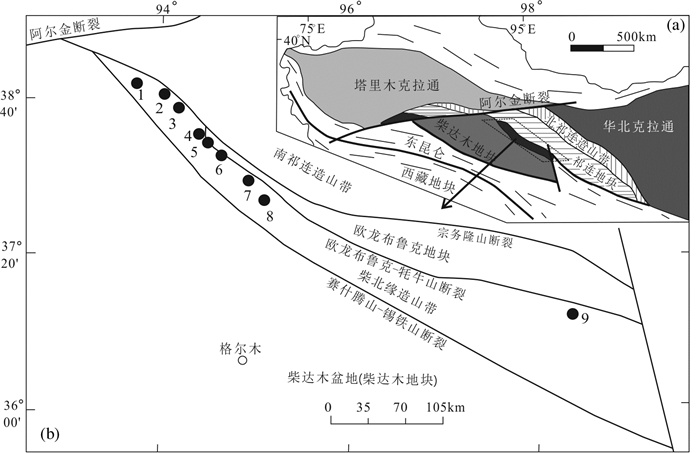
 下载:
下载:
